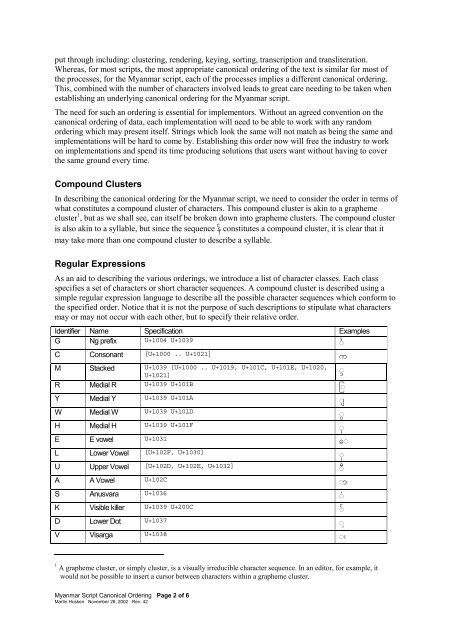Myanmar Script Canonical Ordering - SIL International
Myanmar Script Canonical Ordering - SIL International
Myanmar Script Canonical Ordering - SIL International
You also want an ePaper? Increase the reach of your titles
YUMPU automatically turns print PDFs into web optimized ePapers that Google loves.
put through including: clustering, rendering, keying, sorting, transcription and transliteration.<br />
Whereas, for most scripts, the most appropriate canonical ordering of the text is similar for most of<br />
the processes, for the <strong>Myanmar</strong> script, each of the processes implies a different canonical ordering.<br />
This, combined with the number of characters involved leads to great care needing to be taken when<br />
establishing an underlying canonical ordering for the <strong>Myanmar</strong> script.<br />
The need for such an ordering is essential for implementors. Without an agreed convention on the<br />
canonical ordering of data, each implementation will need to be able to work with any random<br />
ordering which may present itself. Strings which look the same will not match as being the same and<br />
implementations will be hard to come by. Establishing this order now will free the industry to work<br />
on implementations and spend its time producing solutions that users want without having to cover<br />
the same ground every time.<br />
Compound Clusters<br />
In describing the canonical ordering for the <strong>Myanmar</strong> script, we need to consider the order in terms of<br />
what constitutes a compound cluster of characters. This compound cluster is akin to a grapheme<br />
cluster 1 , but as we shall see, can itself be broken down into grapheme clusters. The compound cluster<br />
is also akin to a syllable, but since the sequence ef constitutes a compound cluster, it is clear that it<br />
may take more than one compound cluster to describe a syllable.<br />
Regular Expressions<br />
As an aid to describing the various orderings, we introduce a list of character classes. Each class<br />
specifies a set of characters or short character sequences. A compound cluster is described using a<br />
simple regular expression language to describe all the possible character sequences which conform to<br />
the specified order. Notice that it is not the purpose of such descriptions to stipulate what characters<br />
may or may not occur with each other, but to specify their relative order.<br />
Identifier Name Specification Examples<br />
G Ng prefix U+1004 U+1039<br />
ýF<br />
C Consonant [U+1000 .. U+1021]<br />
u<br />
M Stacked U+1039 [U+1000 .. U+1019, U+101C, U+101E, U+1020,<br />
ýN<br />
U+1021]<br />
R Medial R U+1039 U+101B<br />
]ý<br />
Y Medial Y U+1039 U+101A ýs<br />
W Medial W U+1039 U+101D<br />
ýG<br />
H Medial H U+1039 U+101F ýS<br />
E E vowel U+1031 aý<br />
L Lower Vowel [U+102F, U+1030] ýk<br />
U Upper Vowel [U+102D, U+102E, U+1032] ýD<br />
A A Vowel U+102C ým<br />
S Anusvara U+1036 ýH<br />
K Visible killer U+1039 U+200C ýf<br />
D Lower Dot U+1037<br />
ýh<br />
V Visarga U+1038 ý:<br />
1 A grapheme cluster, or simply cluster, is a visually irreducible character sequence. In an editor, for example, it<br />
would not be possible to insert a cursor between characters within a grapheme cluster.<br />
<strong>Myanmar</strong> <strong>Script</strong> <strong>Canonical</strong> <strong>Ordering</strong> Page 2 of 6<br />
Martin Hosken November 26, 2002 Rev: 42
















